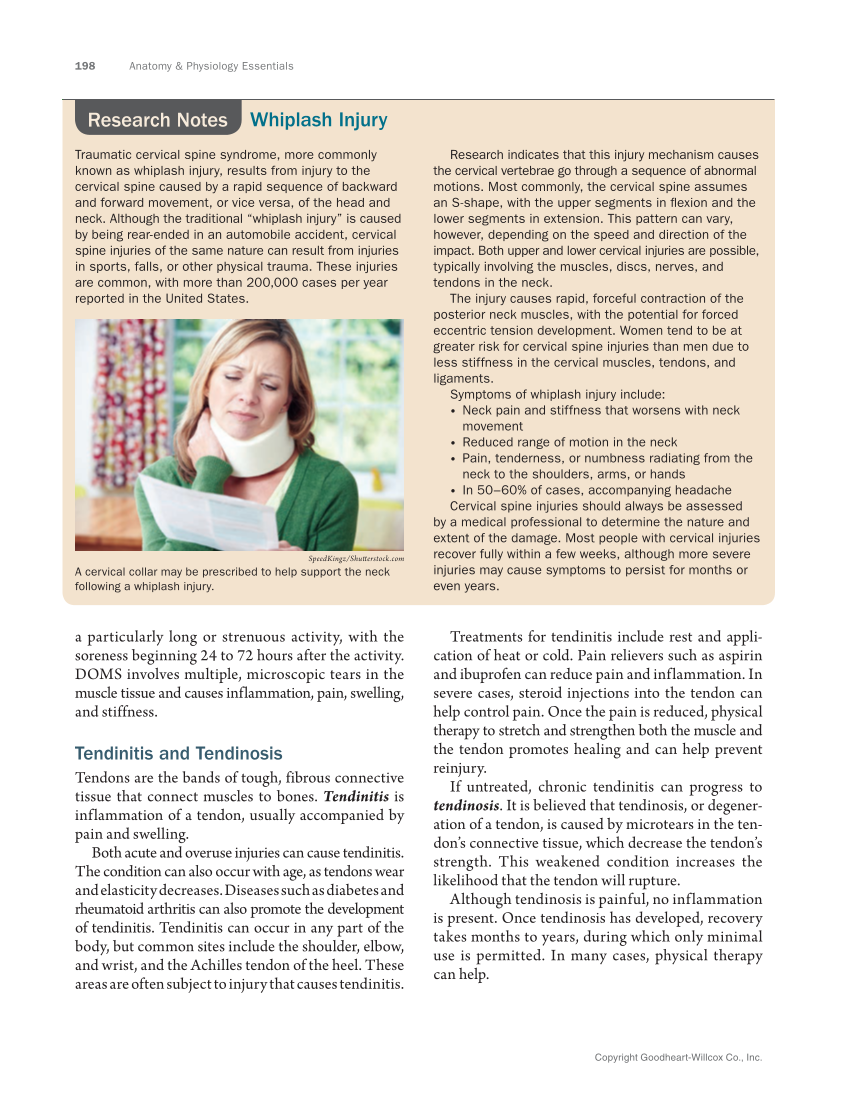198 Anatomy & Physiology Essentials Copyright Goodheart-Willcox Co., Inc. Treatments for tendinitis include rest and appli- cation of heat or cold. Pain relievers such as aspirin and ibuprofen can reduce pain and inflammation. In severe cases, steroid injections into the tendon can help control pain. Once the pain is reduced, physical therapy to stretch and strengthen both the muscle and the tendon promotes healing and can help prevent reinjury. If untreated, chronic tendinitis can progress to tendinosis. It is believed that tendinosis, or degener- ation of a tendon, is caused by microtears in the ten- don’s connective tissue, which decrease the tendon’s strength. This weakened condition increases the likelihood that the tendon will rupture. Although tendinosis is painful, no inflammation is present. Once tendinosis has developed, recovery takes months to years, during which only minimal use is permitted. In many cases, physical therapy can help. a particularly long or strenuous activity, with the soreness beginning 24 to 72 hours after the activity. DOMS involves multiple, microscopic tears in the muscle tissue and causes inflammation, pain, swelling, and stiffness. Tendinitis and Tendinosis Tendons are the bands of tough, fibrous connective tissue that connect muscles to bones. Tendinitis is inflammation of a tendon, usually accompanied by pain and swelling. Both acute and overuse injuries can cause tendinitis. The condition can also occur with age, as tendons wear and elasticity decreases. Diseases such as diabetes and rheumatoid arthritis can also promote the development of tendinitis. Tendinitis can occur in any part of the body, but common sites include the shoulder, elbow, and wrist, and the Achilles tendon of the heel. These areas are often subject to injury that causes tendinitis. Whiplash Injury Traumatic cervical spine syndrome, more commonly known as whiplash injury, results from injury to the cervical spine caused by a rapid sequence of backward and forward movement, or vice versa, of the head and neck. Although the traditional “whiplash injury” is caused by being rear-ended in an automobile accident, cervical spine injuries of the same nature can result from injuries in sports, falls, or other physical trauma. These injuries are common, with more than 200,000 cases per year reported in the United States. Research indicates that this injury mechanism causes the cervical vertebrae go through a sequence of abnormal motions. Most commonly, the cervical spine assumes an S-shape, with the upper segments in flexion and the lower segments in extension. This pattern can vary, however, depending on the speed and direction of the impact. Both upper and lower cervical injuries are possible, typically involving the muscles, discs, nerves, and tendons in the neck. The injury causes rapid, forceful contraction of the posterior neck muscles, with the potential for forced eccentric tension development. Women tend to be at greater risk for cervical spine injuries than men due to less stiffness in the cervical muscles, tendons, and ligaments. Symptoms of whiplash injury include: • Neck pain and stiffness that worsens with neck movement • Reduced range of motion in the neck • Pain, tenderness, or numbness radiating from the neck to the shoulders, arms, or hands • In 50–60% of cases, accompanying headache Cervical spine injuries should always be assessed by a medical professional to determine the nature and extent of the damage. Most people with cervical injuries recover fully within a few weeks, although more severe injuries may cause symptoms to persist for months or even years. Research Notes SpeedKingz/Shutterstock.com A cervical collar may be prescribed to help support the neck following a whiplash injury.
